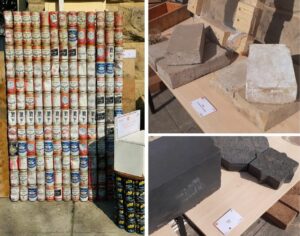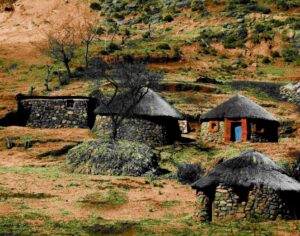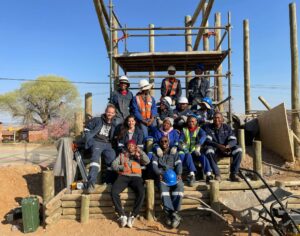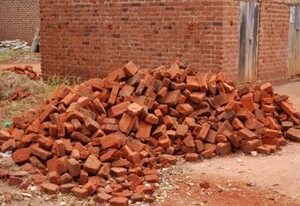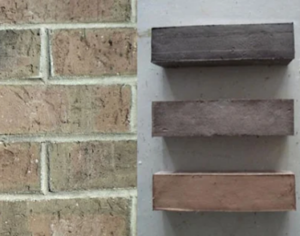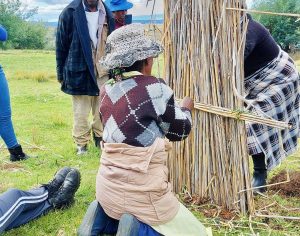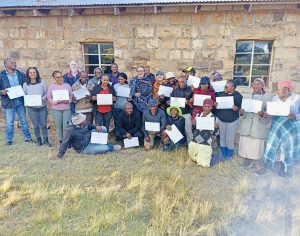Building with Straw and Grass
Desk Research & Primary Findings
Issued on: 30 August 2023
Table of Contents
1. Background
1.1 Overview of Straw and Grass as a Building Material
Grassland vegetation has dominated Lesotho’s landscape for the last 23,000 years or more, as documented by Oppong 2008. However, over time Lesotho’s grasslands have been substantially transformed by human activities to provide shelter and insulation before industrialised roofing and brick materials were introduced, according to Oppong (2008). Grass and straw have been used since the early 1600s for roofing and to build walls by mixing clay with cereal straw or grass and laid up on top of one another into a free-standing wall. Today the materials are most commonly found in rural villages, lodges, guest houses, and historical buildings as a homage to traditional methods of building and roofing.
However, in recent years migration patterns within the country and outside have resulted in the material being replaced with modern alternatives such as metal roofing and concrete blocks especially in urban, peri-urban, and to a small extent in rural areas. The apparent shift from using the material has been due to the fact that grass and straw is viewed as low-cost, and it is associated with traditional housing, mostly used by people in rural areas with little or no source of income to afford modern materials (Oppong, 2008).
According to Oppong (2008) although thatched roofs have been common in Lesotho since ancient times, in the present day, the lack of incorporation of thatch roofing and the use of compressed straw in a more modern architectural world to meet the housing needs in the country reduces the prospects for sustainable development.
2. Types of Straw and Grass used as a Building Material in Lesotho
In Lesotho, there are two varieties of grass suitable for roofing and insulation: cereal and natural/wild grass, found in different regions. Lesotho can be divided into four major ecological zones namely; the Highveld Grassland, Afromontane(foothills), Afroalpine(lowlands), and Senqu Valley, which are home to a variety of grasses and agricultural produce.
2.1. Cereal straw
Due to the unique climate and soil conditions in Lesotho, the most common cereal crops are maize, wheat, and sorghum which are the primary grains consumed locally. There are byproducts from the harvesting of these crops that can be incorporated into the built industry, particularly as roofing materials and for insulation. In Lesotho, wheat straws have been used for roofing, particularly in the highlands of Lesotho. This is due to the fact that highland districts such as Thaba-Tseka, Mokhotlong, Qacha, and Quthing were identified as the top-producing regions for straw in the country [1] (The Lesotho Vulnerability Assessment Committee’s Crop Estimates report for, 2022).
However, the introduction of compressed straw as an insulation material has not been instigated in Lesotho. The compressed straw buildings were first constructed in the late 1800s in Nebraska, USA with the development of steam-powered balers. Even in earlier days, walls made from either tired bundles of straw coated with clay or compacted loose straw mixed with clay have been constructed for centuries throughout Asia and Europe. With the growing awareness of the strong and risky effects on climate, the notion of both reducing carbon costs and carbon sequestration has led to the effective use of compressed straw as a building (Sarath, C & Kumar. B, 2012). Therefore, there is an opportunity to explore compressed straw as a possible building technique for contemporary building standards and preferences in Lesotho (See Figure 1 which shows compressed straw).
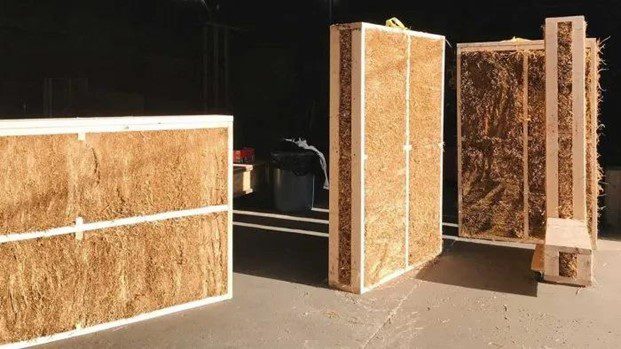
2.2. Wild grass
In Lesotho there are four different types of wild grass available that can be used for thatch: qokoa (Hyparrhenia tamba), mohlomo (Hyparrhenia hirta), tsaane (Eragrostis chloromelas), and lehlaka (Phragmites australis), available in different districts in different quantities (Kose, 2021). It is important to note that some of the naturally growing grasses, like qokoa and mohlomo, are legally protected and are prone to sociopolitical controls that may influence their availability for use in the built industry. Another important issue to note is that some of these grasses may be farmed, which again has an impact on the availability of the grass. These socio-political aspects of grass use in the building industry are explored in detail later in this paper (See Figure 2, which shows the Agro-ecological zone).
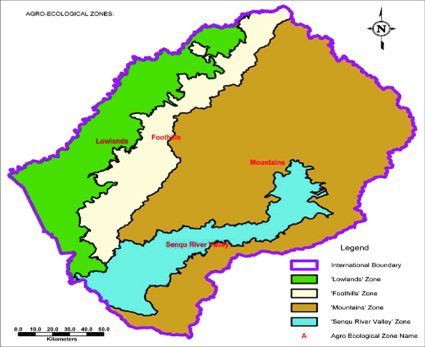
2.2.1. Highveld Grassland ( Lowlands)
This zone spans from the western lowlands of Lesotho starting at the lowest point (1400 m.a.s.l) which includes the Southern region of the Senqu Valley and extends to about 1800 m.a.s.l. Its main vegetation consists of grass species, the bulk of which are Hyparrhenia Hirka mohlomo and qokoa.
Mohlomo typically grows on mountains and between mountain slopes. According to the Ministry of Natural Resources World Wetlands Day report in 2004, mohlomo is considered to have the best quality among all types of wild grass for thatch in Lesotho, and its quality is comparable to that of thatch used in South Africa. It can last for 20 years or more (See Figure 3).
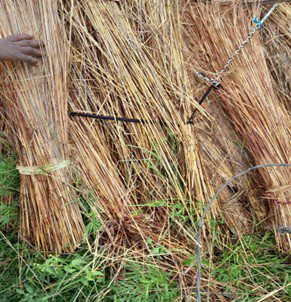
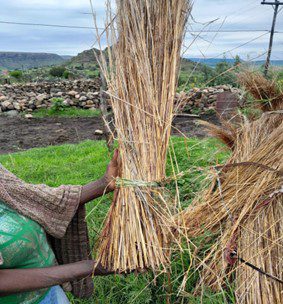
Qokoa, on the other hand, has larger stalks, is less durable, and rots more easily. It is also available in the northern parts of Lesotho
Tsaane is found in the Southern regions of Lesotho. It is characterised by short stalks which make it less durable because it allows water to penetrate in the house.
2.2.2 Afromontane Grassland Zone ( Foothills)
This zone ranges from 1800 m.a.s.l to around 2500 m.a.s.l in altitude. Geographically, it ranges from the upper Senqu Valley to the watershed, covering most of the Maloti Mountain range in the centre of the country. The foothills also include parts of the Drakensberg mountain range in the north as well as the eastern side of the Senqu Valley. It has a wide range of grasses mainly mohlomo and qokoa and it grows successfully due to the volcanic soil and warmer temperatures. They are a significant region for the natural growth of a variety of grasses that can be used in the built industry.
2.2.3 Wetlands Zones
The wetlands are mostly in the lowlands, particularly in the Districts of Berea and Maseru which is where water reed (Phragmites australis) commonly known as lehlaka can be found. It is a highly durable building material, lasting up to 20 years or more.
3. Application of Straw and Grass
Historically, a typical grass-thatched hut was constructed on a circular foundation dug into the ground. Long, flexible poles were inserted into the foundation (Mokorosi, 2017), as shown in Figure 4 with the top bent inwards and tied together to create a hemispherical shape. Thinner poles or split poles were woven in and out of the larger poles, and grass was used for thatching. The grass would usually extend to the ground, forming a beehive-like structure for the hut (Casalis, 1861; Dreyer, 1993; Mokorosi, 2017). Mud was sometimes applied to the outside of the huts as well (Casalis, 1861, See Figure 4)
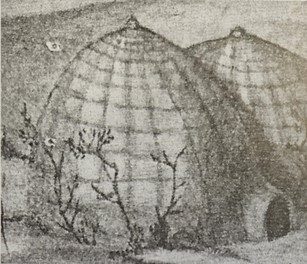
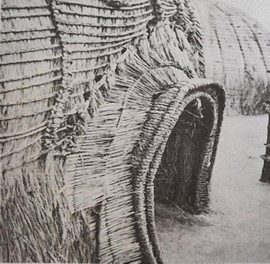
In the 1900s, there was a shift away from grass-thatched huts to more durable materials such as stone, earth, and timber. These materials were all locally sourced, and water and cow dung were used as binders. Traditional huts began to feature stone foundations and walls, with thatch being used primarily as a roofing material (Mokorosi, 2017). During the 20th century, the most common traditional house type in Lesotho was the rondavel, which could be either circular or rectangular in plan (Anderson & Stovre, 1997; Liechti & Hill, 2019, See Figure 5a and 5b).
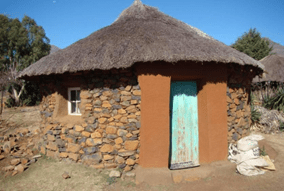
According to a report by New Media (2020), various techniques and equipment are employed when building with thatch, and specific dimensions and angles need to be followed when roofing with thatch. The report states that a thatched roof should have a minimum pitch of 45 degrees and a minimum of 35 degrees over dormer windows. To achieve a smoother thatched roof, the Thetho tool, also known as deskspa (Language used by Basotho thatchers), is used. The smoother the finish, the better the water will run from it, preventing leakages and prolonging the roof’s lifespan.
As per Premier Guarantee (2022), wild thatch is first placed in position and then raked to give it a “poured onto the roof” appearance. For new work, the overall thickness of natural thatch is 400mm, while cereal straw has a much neater and trimmed look. During installation, the thatcher dresses and knocks the thatch into shape, and the overall thickness for new cereal straw work ranges from 300-450mm (Premier Guarantee, 2022).
Additionally, straw and reed can be used for insulation by placing the materials directly onto the rafters in order to provide support and insulation for the corrugated iron roofing. While this material is most abundant in wet lowland areas, it has become increasingly scarce in recent years due to the degradation of wetlands, particularly in Koro-koro and Qalabane (Ministry of Natural Resources, World Wetlands Day, 2004) (See Figure 6).
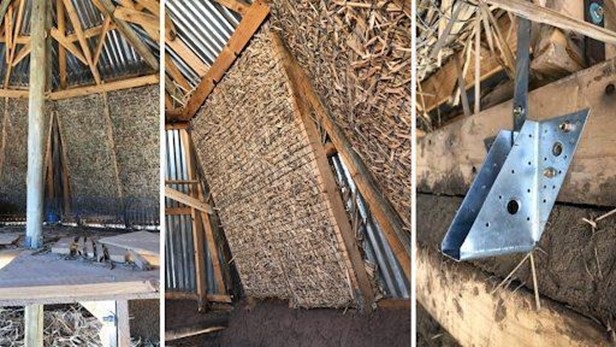
4. Advantages of Straw and Grass as Building Material
According to Stronbach & Walter, 2022, building with straw and grass significantly reduces both embodied and operational carbon compared to construction with conventional materials due to the absence of energy required during its harvesting process. Also, straw stores CO2 which remains locked up in the structure of straw buildings. It is also thermally efficient, renewable, biodegradable, and readily available in Lesotho, particularly cereal straw and Mohlomo and Qokoa grasses.
In comparison to all other roofing materials such as metal sheets, thatch has a higher insulation value as can be seen in the Material Specification Table in Annex XX[1] . As a result, buildings with grass and straw walls are more thermally efficient, reducing the amount of energy required for heating during winter and cooling in summer. This not only benefits the environment but also provides economic benefits by reducing the consumption of fossil fuels such as paraffin and charcoal used for heating in Lesotho’s long and bitterly cold winters. The density of compressed straw in construction influences the air gaps between the stalks and between the bales themselves and therefore the thermal conductivity efficiency. Compressed straws are high-performing insulators and experience minimal decomposition over time (Marlow, 2021).
5. Disadvantages of Straw and Grass as Building Material
Stronbach and Walter (2015) reported that grass and straw are vulnerable to fire. Lightning strikes and open-flame cooking fires are often the culprits. In the absence of building standards about thatch in Lesotho, we referenced South Africa’s thatched roof construction law and standards (SANS 10407). It states that insurance premiums for grass and straw buildings are much more expensive than other roofing materials such as clay tiles, due to their vulnerability to catching fire which can also affect neighbouring buildings.
Additionally, Marlow (2021) pointed out that the quality of straw and grass is dependent on good weather during germination, cultivation, and harvest, which is often reliant on hard-to-find casual labour and old manual equipment. Consequently, harvesting and processing costs are increasing, and the quality of the grass and straw is often poor, necessitating the use of expensive thatch sealants. As a result, many building owners are turning to alternative materials, leading to a decline in demand for thatch roofing.
The issue of durability is another concern for thatch roofing, despite that a well-maintained thatched roof can last up to 20 years, which is comparable to or longer than other competing materials. However, due to improper drying, a lack of access to superior grass species, and possible termite infestation, many thatched roofs may require replacement more frequently than the expected lifespan of 20 years, leading to a shift towards corrugated iron as a cheaper and faster to install alternative. Additionally, thatch is vulnerable to damage from hail, further exacerbating problems with thatched roofing (Marlow, 2021).
6. Primary Explorative Research Findings
6.1 Research Methodology
To collect primary data, a stratified sampling technique was used based on different qualifying criteria which were all aligned with the number of years of experience from 10 years or more. The selection criteria of the interviewees were based on their qualifications, skills, and knowledge because it was imperative to select participants with a first-hand understanding of thatch from a wide range of occupations. The participants were not paid to take part in the interviews. A set of questions, (see here research questions on thatch)[2] was prepared with the aim of gathering information about some specific topics such as availability, accessibility, cost, durability, and knowledge around construction techniques with thatch.
The chapter is divided by topic and summarises the information collected from the interviews, presenting the key findings. A total of 11 interviews with thatch experts and professionals have been conducted from January to June 2023; the researchers conducted face-to-face interviews, which lasted around 45 minutes each, to gain insights into people’s experiences, opinions, and facts about thatch in Lesotho. The respondents represented the entire spectrum of the thatch industry in Lesotho ranging from government officials through skilled professionals and built industry experts. On average our respondents had 24.5 years of experience ranging from 7 years to 41 years.
6.1.1. Availability of Grass & Straw in Lesotho
Seven of the Respondents confirmed our desk research findings that the different grasses in Lesotho can be found in the three ecological zones: Highveld Grassland, Afromontane Grassland, and Afro-alpine Grassland. The Respondents stated that the availability of grass and straw is highly dependent on the season. The Respondents further stated that grasses are available in abundance during the Spring harvesting season when the grass is dry, while cereal straw is available in Winter, particularly in June and July. Although the majority of respondents said that the three kinds of grass (Qokoa, Tsaane & Mohlomo) are available in abundance.
Three of the respondents opposed that viewpoint and claimed that both grass and cereal thatch are deteriorating in quality and quantity. The respondents further mentioned the changing climate, combined with insufficient management of this resource and land use, has resulted in the need to import thatch from South Africa particularly to build and maintain some of the historical buildings and lodges. Also, respondents indicated that, in recent years the government has shifted from using grass as a roofing material to using modern building materials when building public infrastructure like the new museum.
Respondents also stated that overgrazing and deforestation have led to a reduction in the production of natural grass for thatch.
6.1.2. Cost of Grass and Straw in Lesotho
Our goal was also to understand the short and long-term costs of using grass and straw. These covered the purchase of the raw materials, the cost of labour, the ongoing cost of maintenance as well as any reduction in heating costs given the postulated thermal efficiency of thatch. Six of the Respondents, who are experts in roofing & ministries, indicated that the use of thatch is expensive in the short term due to the costs of labour and cost of material since grass is only available at no cost for the residing local communities and not to external parties residing outside of the communities. Additionally, Respondents further stated that the majority of the suppliers stockpile the material in order to raise the prices while also reducing the size of bundles.
In contradiction to our desk research which found that Lesotho’s quality of grass and straw matched South African standards, two Respondents outlined that poor quality material and lack of skilled labour in Lesotho to build large structures has resulted in the Ministry of Tourism importing these resources from South Africa to build the Thaba Bosiu cultural village. The Respondents indicated that the cost of labour sourced in Lesotho is expensive, costing M400.00 (EUR 20) per square metre. Compared to metal or clay roofing which incurs labour costs of M45.00 (Euro 2.25) per square metre respectively.
However, five of the Respondents argued that there are short-term and long-term benefits of using this material in that there are short-term benefits as the material is essentially cheap, costing M10.00 (Euro 0.50) per bundle. The Respondents further stated that the material is free for the suppliers residing in areas where the grass is available because grassland is held communally. The use of resources is regulated by chiefs and village councils who allocate pieces of land, called ‘litema’, to individual households to harvest for free. Additionally, the Respondents expressed that buying the material from individual households who are the primary suppliers of the material in Lesotho makes the buying price cheap mainly because a lot of suppliers are not formally employed, they have resorted to selling thatch as a way of supporting their families therefore the price is negotiable. The Respondents further outlined that because wheat is already being cultivated in the country each household can grow it, making it free. Furthermore, the Respondents indicated that there are long-term benefits that involve an 80% reduction in the cost of heating materials due to their thermal efficiency.
6.1.3. Quality & Durability of Grass and Straw in Lesotho
Eleven of the Respondents explained that the different types of grass have different qualities and characteristics that affect the lifespan and maintenance of thatched roofs and insulation. The respondents stated that in the previous years, Mohlomo was considered to be the best quality among the different types of grass with an expected lifespan of about 20 years without requiring any maintenance. However, the eleven Respondents expressed that in recent years the quality of Mohlomo has deteriorated and needs maintenance after approximately 3 to 5 years due to the poor quality of grass species and the harsh weather conditions. Respondents also articulated that cereal straw is also no exception as the amount of yield and quality have decreased meaning that regular maintenance of roofing is needed every 8 months or so. The Respondents asserted that the quality of Qokoa and Tsaane has also been negatively affected by changing climatic conditions and land degradation.
To address this, Respondents declared that modern materials like thatch sealer (a solution that has to be sprayed on both sides of the thatch to prevent moisture from entering into the structure) have been used to improve its longevity, but it comes at a high cost of M4,000 (EUR200) for 20 litres which is the amount that is needed for a typical standard size rondavel.
6.2 Knowledge and Techniques of Grass and Straw in Lesotho
All of the eleven Respondents indicated that there is a shortage of skilled thatchers and that the trade is dying out. Additionally, the Respondents further showed that due to the informal nature of these artisans, little information exists on the availability of skilled thatchers, and there is no database or Trade Association, or formal entity for thatchers. Also, the Respondents made further indications that the new generation shows little interest in learning this technique. The Respondents further confirmed that the lack of or no skilled labour capable of roofing large structures results in skilled thatchers being sourced from South Africa. Therefore, a list of skilled Thatchers’ is needed to help formalise the sector and encourage young people to take up the thatching trade within the built environment by providing it as a trade in the vocational and technical schools.
7. Feasibility of Grass and Straw
Lesotho’s thatch market is highly dependent on the demand for cultural and tourism-related buildings such as lodges and restaurants which contribute highly to the economy and to the preservation of Basotho’s culture. However, skilled thatchers are scarce and overly expensive if you find one, making it a costly material in the short term that is not available throughout the year and production is highly susceptible to climatic change.
8. Distribution Patterns of Grass and Straw
Community members are the primary distributors of thatch; as mentioned above they are given rights by the Chief as the land is held communally in the country and regulated by them. It’s usually sold informally on demand when someone needs it, and not sold in any markets or hardware stores.
It is not a fragile material, hence it is easy to transport and does not require special packaging. When stored properly, thatch can last for a long time without going rotten.
Distribution patterns depend on policymakers and decision-makers as areas where it’s available need to be mapped out, and regulations on who can have access to the land on which it grows need to be developed before it can be distributed to the public on a large scale.
9. Unmet needs of Grass and Straws in Lesotho
The main unmet need regarding the grass and reeds for thatch is the lack of documented information about the location of natural thatch resources (such as water reeds and wild grass for thatch), which makes it challenging to determine their availability in the country.
Furthermore, the traditional knowledge and techniques used in thatch roofing are often not recorded and are only known by a small group of elderly community members. Unfortunately, some of these skilled thatchers pass away without transferring their knowledge to the younger generation, making these techniques even more scarce.
10. Conclusion
The fact that the grass for thatch is not readily available to the mass market, and thatchers are not recognized as a formal profession, thatch remains a cottage artisanal industry in Lesotho. The decrease in the use of thatch for roofing and insulation has led to an increase in the use of modern building materials that are not sustainable: economically, environmentally, and socially. This is because of the notion that thatch is not available in the country due to no mapped-out areas showing its availability and accessibility.
Additionally, the lack of a documented list of skilled personnel with knowledge of the material has contributed to the shift away from using this material. However, thatch roofing and straw insulation as well as compressed straw bales offer plausible alternative solutions in the development of sustainable housing in Lesotho to meet the outstanding housing needs. Hence, there is a need to revive this material to promote its thermal efficiency, which results in an 80% reduction of costs in heating and cooling and also lower carbon emissions from the extraction process and the use of the material.
11. Recommendations
It is important for the government and other relevant stakeholders to conduct a comprehensive survey to document the knowledge and techniques applied when roofing with thatch, map out the areas of availability and accessibility of natural grass for thatch, and provide training and formalisation of the skillset of thatch. This will not only preserve this valuable cultural heritage but also create job opportunities, promote the use of sustainable and locally available materials, and contribute to Lesotho’s efforts to reduce carbon emissions by lowering the use of alternative heating fuels due to the thermal efficiency of the material. Also, little or no energy is used when harvesting and building using the material. Furthermore, there is a need for advocacy and awareness-raising campaigns to promote the use of thatch as a roofing and insulation material in urban, rural, and peri-urban areas and its benefits to the environment and the economy.
In addition to mapping out areas where thatch is available, it would also be important to create a database of skilled thatchers to preserve and pass on their knowledge to future generations. This could be done through apprenticeships, training programs that can last up to 8 weeks, and certification courses, which would provide a path to formalise the skillset and make it a viable career option for younger people. By promoting the use of thatch as a sustainable and cost-effective roofing material in the long run, and providing the necessary support and resources for its cultivation and preservation, the country can create a thriving industry that benefits both the economy and the environment.
Different approaches need to be adhered to in order to lower the cost of using the material through preservation and exchange of skills which will help lower the need to hire external labour outside of the country and to import thatch while also leading to the abundance of the material through improved conservation majors.
12. Appendix
Appendix A: Table of Respondents
| Respondent No | Name of Company/ Profession | Number of years of Experience | Profession |
| Respondent 1 | Entrepreneur | 30 years | Skilled thatcher |
| Respondent 2 | Ministry of Tourism | 22 years | Director Tourism |
| Respondent 3 | Ministry of Environment | 13 years | Environmental Spet |
| Respondent 4 | Entrepreneur | 22 years | Thatch supplier |
| Respondent 5 | Entrepreneur | 7 years | Architectural designer |
| Respondent 6 | Building and Design services | 35 years | Head of Architecture |
| Respondent 7 | Entrepreneur | 30 years | Skilled thatcher |
| Respondent 8 | Entrepreneur | 40 years | Skilled thatcher |
| Respondent 9 | Entrepreneur | 12 years | Skilled thatcher |
| Respondent 10 | Entrepreneur | 17 years | Skilled thatcher |
| Respondent 11 | Thatch supplier | 41 years | Thatch Supplier |
13. BIBLIOGRAPHY
Ashour, T. & Wu, W. 2011. Using Barley Straws as Building Material. https://www.researchgate.net/publication/287478964_Using_barley_straw_as_building_material
Casalis, E., A., 1861. The Basutos. J. Nisbet. Retrieved from: https://doi.org/10.5479/sil.262374.39088000167106
Chen, J. Elbashiry, E. & Yu, T. 2017. Research progress of wheat straw and rice straw cement-based building materials in China https://www.researchgate.net/publication/318480337_Research_progress_of_wheat_straw_and_rice_straw_cement-based_building_materials_in_China
Dreyer, J. 1993. The Basotho hut: From Late Iron Age to the present. South African Journal of Ethnology, 16(3) https://journals.co.za/doi/pdf/10.10520/AJA02580144_730
Lesotho Vulnerability Assessment Committee Crop Estimates, 2022. https://drmims.sadc.int/en/organizations/lesotho-vulnerability-assessment-committee-lvac
Marlow, C. 2021. Traditional Straw Thatching in Time of Shortage. https://historicengland.org.uk/content/docs/advice/traditional-straw-thatching-times-of-shortage-context167-mar21/
Ministry of Natural Resource, 2004. World Wetlands Day. https://www.ramsar.org/news/world-wetlands-day-2004-lesotho
Mokorosi, S. A. 2017. Basotho Traditions: Indigenous Architecture and Creativity. Morija Printing Works. https://searchworks.stanford.edu/view/13170501
Oppong, R. 2008. A Trio Sub- Saharan African Compendium: “Losing the sense of thatch” http://dev.ecoguineafoundation.com/uploads/5/4/1/5/5415260/thatched_roofs.pdf
Premium Guarantee, 2022. Thatched Roofing: Interaction with Modern Construction Techniques. https://www.premierguarantee.com/our-services/structural-warranties/
Stronbach, B. & Walters, W. 2015. An overview of grass species used for thatching in the Zambezi, Kavango East, and Kavango West Regions, Namibia. researchgate.net/publication/286447092_An_overview_of_grass_species_used_for_thatching_in_the_Zambezi_Kavango_East_and_Kavango_West_Regions_Namibia





